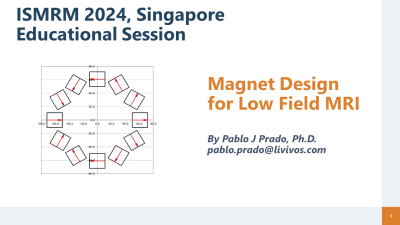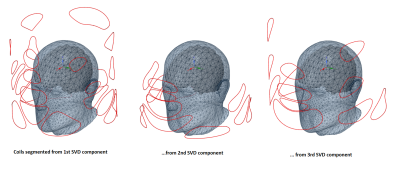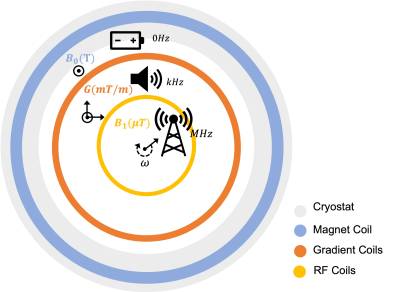Weekend Course
MR Engineering I: MRI System (Non-RF)
ISMRM & ISMRT Annual Meeting & Exhibition • 04-09 May 2024 • Singapore

| 07:45 |
 |
Magnet Design for Ultra-Low Field MRI Systems
Pablo Prado
Keywords: Physics & Engineering: Low-field MRI, Physics & Engineering: Hardware Low-field MRI scanners offer imaging solutions for point-of-care settings with simplified facility needs. The lower magnetic field range could lead to reduced scanner costs and footprint, facilitating installations in economically disadvantaged regions. However, performance and cost challenges often restrict low-field units to specific clinical applications such as brain and extremity imaging. Developing low-field magnets for clinically valuable applications requires balancing magnetic field homogeneity, strength, and footprint. The presentation explores market trends and details of low-field magnet development. |
| 08:10 |
Gradient Coil Design
Ergin Atalar
s
|
|
| 08:35 |
 |
Shim Coil Design
Alexis Amadon, Bruno Pinho Meneses
Keywords: Physics & Engineering: Hardware, Physics & Engineering: High-Field MRI, Neuro: Brain We review methods to design shimming coils, starting from basic Spherical Harmonic coils to anatomy-driven multi-coil arrays. Assuming cylindrical surface geometries for the sought shim currents, we focus on a recent simple numerical method to find the stream function (SF) producing whatever target field. Applying this to brain B0 maps, we perform a SF principal component analysis and translate its main components into current lines gathered around SF extrema. We then segment coil windings into multi-channels to add flexibility in the shimming process. The same strategy can be applied to design shim arrays dedicated to other parts of the anatomy. |
| 09:00 |
 |
MRI System Engineering
Natalia Gudino
Keywords: Physics & Engineering: Hardware, Physics & Engineering: High-Field MRI, Physics & Engineering: Low-Field MRI The aim of this presentation is to review the main hardware components in the MRI system and its engineering based on MRI physics. |
| 09:25 |
Break & Meet the Teachers |
|
| 09:55 |
Peripheral Nerve Stimulation
Valerie Klein
Keywords: Physics & Engineering: Gradient & B0 Safety, Physics & Engineering: Hardware Time-varying MRI gradient fields induce electric fields in the patient (Faraday induction) that can stimulate excitable tissues such as peripheral nerve fibers. Peripheral nerve stimulation (PNS) can be experienced as a mild tingling or tapping sensation but can lead to muscle contractions and even pain at higher levels, which must be avoided. With new gradient coil designs and increasing power levels, PNS has become a major limitation to gradient performance and thus imaging speed and resolution. This talk addresses different approaches to characterize and mitigate PNS in MRI and will touch upon other gradient-patient interactions, including cardiac and retina stimulation. |
|
| 10:20 |
 |
Concomitant Field Effects in Cartesian and Non-cartesian MRI
with Asymmetric High-Performance Gradients
Afis Ajala
Keywords: Physics & Engineering: Gradient & B0 Safety, Physics & Engineering: Physics The use of higher-performance gradient coils results in stronger second-order concomitant fields, which can lead to image artifacts such as signal dropout, blurring, and phase errors that cannot be corrected by pre-emphasis of gradient waveforms and/or radio frequency modulation alone. We developed (1) an axially symmetric second-order field coil that is insertable, and demonstrate its ability to prospectively correct the additional phase generated by second-order concomitant fields in 2D phase contrast and spiral-out gradient echo imaging in a 3.0 T high-performance head-gradient (MAGNUS) system and (2) a retrospective second-order concomitant field correction method and demonstrate its efficacy using perfusion MRI. |
| 10:45 |
Who Is the Power Hog? Energy Consumption of an MRI System
Johan Overweg
Keywords: Physics & Engineering: Hardware Superconducting MRI scanners have a high baseline power consumption, This is caused by the cryocooler which is on all the time. There is potential to reduce this power by operating the cryoycooler such that does not generate more cooling than the magnet needs. |
The International Society for Magnetic Resonance in Medicine is accredited by the Accreditation Council for Continuing Medical Education to provide continuing medical education for physicians.